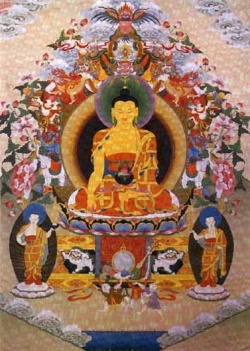Three Systems of Mahayana
by Shi Huimin Bio
Mahayana (or Greater Vehicle) Buddhist teachings developed into three stages or systems. In 1923 the Venerable Taixu (太虛) presented the wisdom of emptiness School (空慧宗, Dharma-nature Emptiness-Wisdom School), the Yogacara School (唯識宗, or the Dharma-characteristics Consciousness-Only School), and the Reality School (真如宗, the Dharma-realm Complete Consciousness School) as the three schools of Mahayana Thought that encapsulate the teachings of Chinese Buddhism.
In 1941, Venerable Yinshun (印順) responded to the core question of “why is there the cycle of Rebirth within the extinction of nirvAna?” Through analysis of the characteristics and development of Indian Mahayana scriptural theories, he presented descriptions of the three Mahayana systems as “Emptiness of its own entity (性空唯名論),” “cognition-only (虛妄唯識論),” and “embryo of the Tathagata (真常唯心論).”
The “Emptiness of its own entity” corresponds to advocates of the theory that “all dharmas lack an inherent essence and are empty,” such as Nagarjuna and Aryadeva.
As all dharmas that are causally produced are provisional (the mundane World is falsely established and false names exist), ultimate examination reveals that no essential substance can originate by itself--”the self has no essence (and is empty).”
However Sentient beings lack this Knowledge and maintain that there is independent origination, which is the cause of the cycle of Rebirth and all vexations.
According to the Explanation of Profound Secrets Sutra (解深密經), as well as the theories of Maitreya, Asanga, and Vasubandhu, “cognition-only” advocates that “baseless differentiation of Mind and Mental objects” explains the World “that appears only in the Consciousness” of Sentient beings.
Furthermore, the idea separates the dyad of “self-nature” as “falsely claimed self nature” and the ultimate as “self nature separate from speech.”
This differentiation avoids certain people’s misinterpretations of “all dharmas having no essence (and are empty)” as meaning complete Emptiness and the denial of Nirvana.
According to the ?r?m?l?dev? Si?han?da Sutra (勝鬘經) and The Lankavatara Sutra (楞伽經), as well as the discourses of the Ratnagotravibhaga Mahayanottaratantra sastra (寶性論) and the Awakening of Faith (起信論), the “embryo of the tath?gata” postulates that the Tathagatagarbha (如來藏) and Buddha-nature present in the eternal Mind or atman (大我) is the basis of both the cycle of Rebirth and nirvana (涅槃).
Interpreting “empty of inherent essence” to mean that “the essence of the Mind is originally pure but is sullied by the accumulation dust.”
Vexations accumulate from the outside (as a foreign particle melds onto the surface) and are not a part of the essence of the Mind.
The tathagatagarbha of Sentient beings is unfettered. When the untainted, pure being fully shines forth, then one can become a Buddha.
“Emptiness of its own entity” can be said to directly reveal that aspect of Buddhism in which “all dharmas lack selfhood.” “cognition-only” elaborates on the principle that “all actions are Impermanent.” “embryo of the tath?gata” emphasizes the “permanence of nirvana.”
The validity regarding the establishment of these three systems and Dharma-master Yinshun’s own partiality to “baselessness and Consciousness only theory” brought about numerous discussions between the Buddhist World and academia.
Chinese Keyword
太虛法師 , 印順法師 , 「性空唯名論」 , 「虛妄唯識論」 , 「真常唯心論」
English Keyword
Venerable Taixu , Venerable Yinshun , Svabhāva-śūnyatā (Emptiness of its own entity) , vijñapti-mātratā (cognition-only) , Tathāgata-garbha (embryo of the Tathāgata)
References
Tai Xu. Fo fa zong xue [[[佛法總學]]]. In Tai xu da shi quan shu di yi pian 太虛大師全書第一篇.
Master Yinshun. (1972). Da sheng san xi de shang que [大乘三系的商榷]. In Wu zheng zhi bian [無諍之辯]. Taipei: Zheng wen.
Master Yinshun. (1994). Cheng fo zhi dao . Zeng zhu ben [成佛之道˙增注本]. Hsinchu: Zheng wen.
Master Yinshun. (1993). You xin fa hai liu shi nian [遊心法海六十年]. In Hua yu ji, Vol.5 [華雨集˙五]. Taipei: Zheng wen.
Guo, Peng. (1992). Yin shun fo xue si xiang yan jiu [印順佛學思想研究]. Taipei: Zheng wen.
Da cheng san xi de shang que. [大乘三系的商榷]. On Yin-Shun Cultural and Educational Foundation. Retrieved from http://www.yinshun.org/Enlightenment/1997/1997oct/1999oct4.htm
Yin-Shun Cultural and Educational Foundation. Retrieved from http://www.yinshun-edu.org/
Yin shun dao shi dui da cheng san xi de bian yi yu rong guan [印順導師對大乘三系的辨異與融貫]. Retrieved from http://www.yinshun.org/Retreat/LectureNotes2007/LSQ-2.pdf
Tai xu da shi quan shu zong mu lu [太虛大師全書總目錄]. Retrieved from http://www.buddhaway.org/T00-taixu.htm
Lan, Jifu. Tai wan fo jiao si xiang shi shang de hou yin xun shi dai [臺灣佛教思想史上的後印順時代].
*印順文教基金會〈大乘三系的商榷〉 http://www.yinshun.org/Enlightenment/1997/1997oct/1999oct4.htm
*印順文教基金會推廣教育中心http://www.yinshun-edu.org/
*印順導師對大乘三系的辨異與融貫www.yinshun.org/Retreat/LectureNotes2007/LSQ-2.pdf
*太虛大師全書總目錄http://www.buddhaway.org/T00-taixu.htm
*藍吉富。〈臺灣佛教思想史上的後

